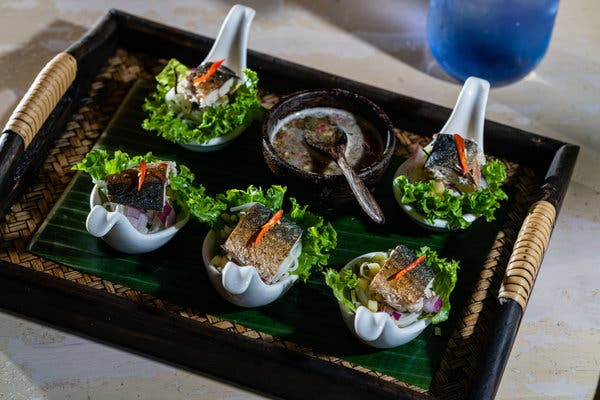The fermented shrimp paste known in Thailand as kapi is notoriously funky, an exaggerated expression of just two ingredients: shrimp and salt. It is also an essential ingredient in the fried rice dish khao kluk kapi.
At Boran in Carroll Gardens, Brooklyn, kapi-stained jasmine rice has a diverse cast of mix-ins. Palm sugar-stewed pork, juicy cucumber and presses of lime are quick to temper that aged-shrimp flavor. Strips of omelet, crunchy Chinese long beans and alarmingly red chiles also mitigate the kapi’s assertive taste.
Boran is the Thai word for ancient. For the restaurant’s head chef and co-owner, Suwat Chalothron, it is practically a mission statement. “I love this name,” he said repeatedly. “I love the history of my country.”
Mr. Chalothron, 56, opened the restaurant in February 2018 with his wife, Penrut Ritbumrung, and his business partner, Patchanan Ruamjaroen, whom he met seven years ago at Nine-D Thai Cuisine, where Mr. Chalothron was a chef.

“He wanted to make food that other Thai restaurants didn’t have,” Ms. Ruamjaroen, 26, said. “I believed in him.”
Mr. Chalothron, who lives above the restaurant, is resolute when it comes to his ingredients. He uses a generations-old family recipe to make his own kapi. (Many restaurants just use store-bought kapi for that hit of savory flavor.) Instead of using peanut butter in his peanut dipping sauce (a common hack), he simmers crushed peanuts in coconut milk for hours. In lieu of using readily available white sugar and vinegar, he opts for imported palm sugar and tamarind.
To start a meal at Boran, consider the miang pla too, silvery-skinned bites of mackerel perched over a knot of rice noodles, cubed ginger, red onion, loose curls of lemongrass and threads of fresh chile, all cupped in a slip of lettuce. The fish is steamed, then seared for a crisp skin. A spoonful of the accompanying fish sauce condiment is vital. Taken in one bite, the dish is a thrill of hot and cold, crisp and soft.
With intentions of breadth, the menu at Boran is not regionally specialized. It traverses Thailand from incendiary curry pastes of the south through the coconut milk-sweetened midlands to the fresh bounty and fermentation of the north and northeast.
Mr. Chalothron is originally from central Thailand, which is known for its curries. Outside Asia, these tend to be syrupy concoctions that border confection, but Mr. Chalothron keeps his structured and balanced. Velvety massaman, served with rice and flaky roti wedges, is evenly calibrated despite being the most ingredient intensive curry in his repertoire.
Kua kling is described on the menu as the best curry paste of southern Thailand, where Ms. Ruamjaroen grew up. The paste fuses ginger, galangal and turmeric — a signature of the south — with fresh and dried chiles, heady lemongrass and makrut lime leaf. It is stir-fried with minced pork and served with a bouquet of chilled leafy vegetables. Each bite made me bleary-eyed, but it’s the dish I can’t stop thinking about.
From a list of fish dishes, larb pla ubon is a tumble of dorade chunks, fried until the skin curls and the meat is flaky. The head-on skeleton gets a quick dip in oil, too, before the fish is piled back on top. It is finished with a fish sauce, lime juice and palm sugar dressing, the Thai canon of salty-sour-sweet. Make this dish the centerpiece of your meal, and you’ll be the envy of anyone who didn’t.
Many courses are served on woven bamboo trays layered with banana leaves. It’s an attractive touch, if slightly impractical. Ordering the appetizer platter alone will prompt the annexation of a vacant table next to yours, assuming there is one.
The northern Thai-inspired Isan set is another oversize tray holding a sprightly som tum salad, minced pork larb and exceptional charred chicken thighs served in a rooster-shaped basket.
As a young chef starting out some 30 years ago, Mr. Chalothron said he didn’t know how to cook Thai food; he just knew how it was supposed to taste. It has taken him a few decades to codify his memory, but the work has its rewards.
“When you eat and are happy,” he said, “I’m happy.”
Follow NYT Food on Twitter and NYT Cooking on Instagram, Facebook, YouTube and Pinterest. Get regular updates from NYT Cooking, with recipe suggestions, cooking tips and shopping advice.




